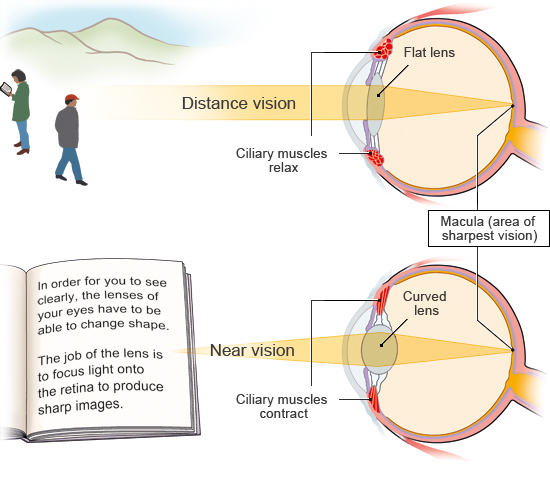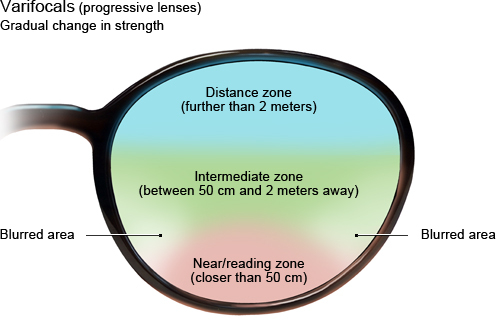NCBI Bookshelf. A service of the National Library of Medicine, National Institutes of Health.
InformedHealth.org [Internet]. Cologne, Germany: Institute for Quality and Efficiency in Health Care (IQWiG); 2006-.
Introduction
It happens to all of us eventually: You have to start holding newspapers or books further away in order to be able to read them and clearly recognize letters without straining your eyes.
Seeing nearby objects less clearly is a normal part of aging. Known as presbyopia, this age-related farsightedness typically becomes noticeable in your mid-forties.
Although there are no effective treatments for the causes of presbyopia, the effects can be corrected. The best and easiest way to do so is using reading glasses.
At a glance
- It is normal for people to start having trouble seeing things close-up in their mid-forties.
- Known as presbyopia, this age-related farsightedness often first becomes noticeable when reading.
- It happens because the eye can no longer focus on nearby objects.
- This problem can easily be corrected with reading glasses.
Symptoms
Early signs of presbyopia usually become apparent when reading. It also gets harder to do things like checking your watch or mobile phone, reading the prices in supermarkets or recognizing people on photos.
At first, this problem is especially noticeable when you're tired or in dim light. It is often still easy to read a short newspaper article. But it gradually gets harder to read for longer periods of time because the letters start blurring. You have to strain your eyes to see clearly and they might start burning. You may also get a headache after a while.
Causes
Your eyes can focus on nearby and faraway objects by changing the shape of their lens. This changes the refractive power (focusing power) of the lens: When looking at faraway objects the lens becomes flatter and thinner. To see nearby objects clearly, the lens becomes curved and thicker with the help of a muscle in the eye. The medical term for these adjustments is accommodation.
The lenses of your eyes become harder and less flexible with age, and your eye muscles probably become weaker too. As a result, the lenses can no longer change shape as easily. This means that it’s harder to see things close-up. But your ability to see faraway objects isn’t affected.

Adjusting to nearby and distant objects
Risk factors
While some people already start having trouble reading or seeing things close-up in their early forties, this may only happen much later in others. It is not clear why that is. What is known, though, is that people who have medical conditions like diabetes, cardiovascular disease or multiple sclerosis may develop presbyopia at a younger age.
Women often start wearing reading glasses at a younger age than men do. This is mainly because they tend to do something about the problem sooner, though. There is no difference between men and women in terms of when presbyopia starts.
Prevalence and outlook
Experts believe that more than one billion people around the world have presbyopia, and this number is expected to grow.
Toddlers can see objects clearly even if they’re right in front of their eyes. This ability is lost as people grow older. A reading distance of about 35 cm is considered to be normal in adults. This distance gradually increases in your early forties, and most of us will need reading glasses by the age of 45. People tend to become increasingly farsighted until around the age of 65 or 70, when presbyopia generally stops getting worse.
In shortsighted people, who have problems seeing distant objects clearly, the effects of presbyopia are usually milder and occur later. Those people can counterbalance these effects by not wearing their glasses.
The hardening of the eye lenses is more of a problem for people who are already farsighted because it then becomes even more difficult for their eyes to adjust to see nearby objects.
Diagnosis
Presbyopia can be diagnosed by an ophthalmologist (an eye doctor) or at an optician's. This involves using a small instrument (a phoropter) to measure the refractive power of your eyes, followed by an eye test to determine the prescription strength needed for corrective lenses. In the eye test you are asked to look at eye charts, a projector screen or other screen. These have letters, numbers or broken rings of decreasing size on them. Because your eyesight is usually different in each eye, your eyes are tested separately by first covering one eye and then covering the other. The test determines what kind of corrective lenses are needed to improve your sight.
Like the refractive power of your natural eye lenses, the refractive power of glasses or contact lenses are measured in diopters (D).

Correcting presbyopia
Prevention
Special eye exercises are sometimes recommended for the prevention of presbyopia. These exercises usually focus on training the eye muscles. Even if there are a lot of descriptions of how to do these eye exercises on the internet or in books, doing them won't prevent presbyopia. Training the muscles in your eyes won't stop your eye lenses from becoming harder and less flexible as you grow older.
Treatment
Although there are no effective treatments to fight the cause of presbyopia, the effects of presbyopia are easily corrected. The simplest way to solve the problem of not being able to see nearby objects is wearing glasses.
Some people use ready-made reading glasses that are available in shops. But the two lenses of these readily available reading glasses have the same lens power, although most people have different vision in each eye. Individually adjusted prescription reading glasses are only available from an optician's, where glasses with the exact required lens power are made especially based on the results of an eye test.
It sometimes makes sense to wear multifocal glasses, such as varifocals. These can, for instance, help to correct nearsightedness at the same time too in people who are both nearsighted and farsighted.

Varifocals (progressive lenses) with gradual change in strength
As an alternative to glasses, contact lenses can also be used to correct the effects of presbyopia.
Laser treatment or surgery to correct presbyopia are possible too. But the only advantage of these approaches, if any, is that you no longer have to wear glasses. They can also lead to side effects and complications, though.
Further information
When people are ill or need medical advice, they usually go to see their family doctor first. You can read about how to find the right doctor in our topic "Health care in Germany" – and our list of questions can help you to prepare for your appointment.
Sources
- American Optometric Association (AOA). Optometric Clinical Practice Guideline: Care of the Patient with Presbyopia. 2011.
- Bourne RR, Flaxman SR, Braithwaite T et al. Magnitude, temporal trends, and projections of the global prevalence of blindness and distance and near vision impairment: a systematic review and meta-analysis. Lancet Glob Health 2017; 5(9): e888-e897. [PubMed: 28779882]
- Charman WN. Developments in the correction of presbyopia I: spectacle and contact lenses. Ophthalmic Physiol Opt 2014; 34(1): 8-29. [PubMed: 24205890]
- Deutsche Ophthalmologische Gesellschaft (DOG), Kommission Refraktive Chirurgie (KRC), Berufsverband der Augenärzte Deutschlands (BVA). Bewertung und Qualitätssicherung refraktiv-chirurgischer Eingriffe durch die DOG und den BVA: KRC-Empfehlungen. Ophtalmologie 2023; 120: 633-644.
- Grehn F. Augenheilkunde. Berlin: Springer; 2019.
- Hickenbotham A, Roorda A, Steinmaus C et al. Meta-analysis of sex differences in presbyopia. Invest Ophthalmol Vis Sci 2012; 53(6): 3215-3220. [PMC free article: PMC3383187] [PubMed: 22531698]
- Kelava L, Barić H, Bušić M et al. Monovision Versus Multifocality for Presbyopia: Systematic Review and Meta-Analysis of Randomized Controlled Trials. Adv Ther 2017; 34(8): 1815-1839. [PubMed: 28674958]
- Lang GK. Augenheilkunde. Stuttgart: Thieme; 2019.
- National Institute for Health and Care Excellence (NICE). Treating presbyopia by inserting an artificial lens in the cornea. 2013.
- Tabernero J, Chirre E, Hervella L et al. The accommodative ciliary muscle function is preserved in older humans. Sci Rep 2016; 6: 25551. [PMC free article: PMC4858807] [PubMed: 27151778]
- Wang L, Moss H, Ventura BV et al. Advances in Refractive Surgery. Asia Pac J Ophthalmol (Phila) 2013; 2(5): 317-327. [PubMed: 26107036]
IQWiG health information is written with the aim of helping people understand the advantages and disadvantages of the main treatment options and health care services.
Because IQWiG is a German institute, some of the information provided here is specific to the German health care system. The suitability of any of the described options in an individual case can be determined by talking to a doctor. informedhealth.org can provide support for talks with doctors and other medical professionals, but cannot replace them. We do not offer individual consultations.
Our information is based on the results of good-quality studies. It is written by a team of health care professionals, scientists and editors, and reviewed by external experts. You can find a detailed description of how our health information is produced and updated in our methods.
- Overview: Age-related farsightedness (presbyopia) - InformedHealth.orgOverview: Age-related farsightedness (presbyopia) - InformedHealth.org
- Rattus norvegicus replication factor C (activator 1) 3, mRNA (cDNA clone MGC:109...Rattus norvegicus replication factor C (activator 1) 3, mRNA (cDNA clone MGC:109141 IMAGE:7383278), complete cdsgi|56789711|gb|BC088281.1|Nucleotide
Your browsing activity is empty.
Activity recording is turned off.
See more...
